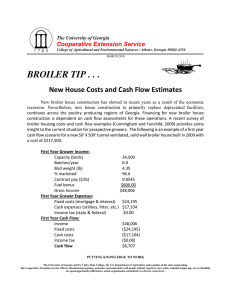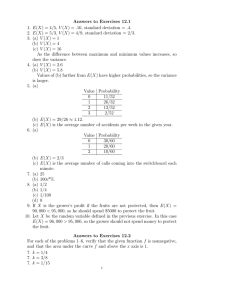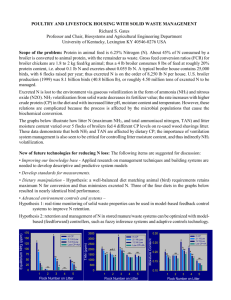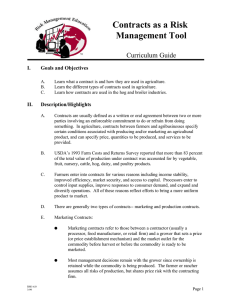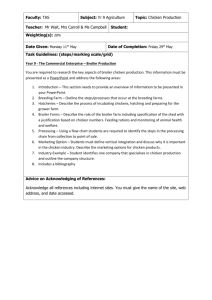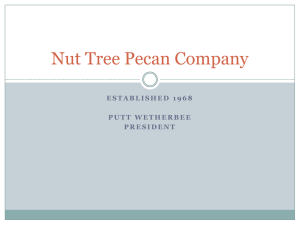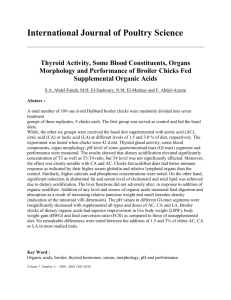Document 12948471
advertisement
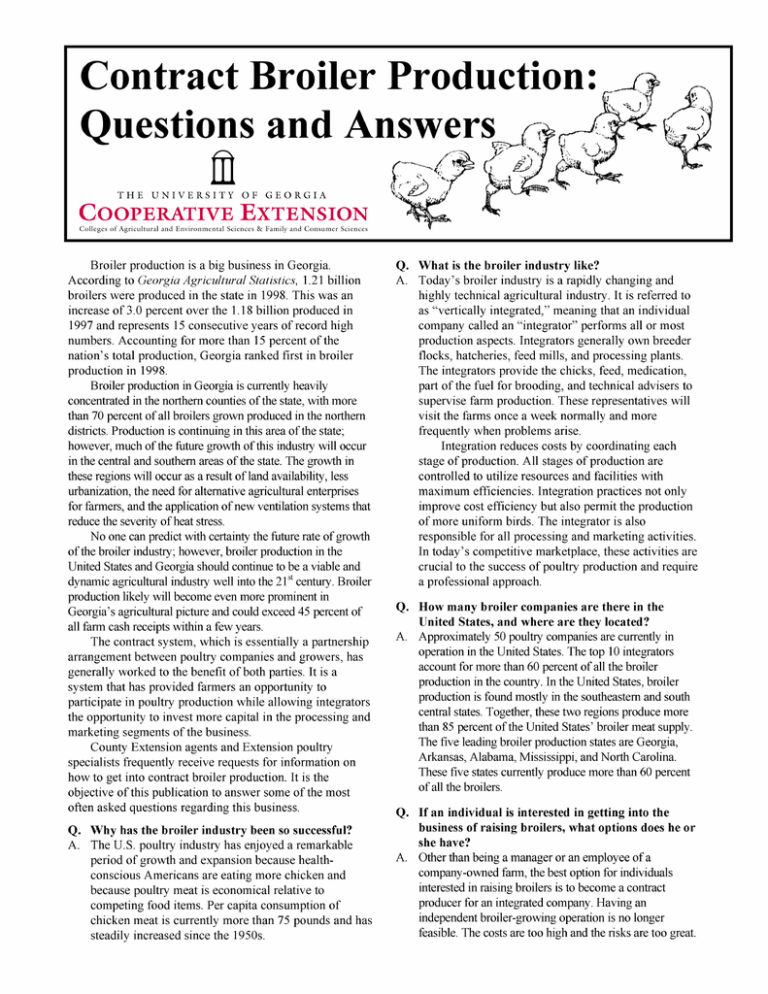
Q. What percentage of broilers are grown under contract? A. Approximately 99 percent of all broilers are produced under contract, with the remaining production occurring on integrator-owned farms. Q. What are broiler grower contracts? A. Grower contracts are legal written agreements between integrators and growers that provide full and complete disclosure of all terms and conditions affecting grower payment for production of poultry. These include: 1. Terms of payment 2. Settlement sheets 3. Grouping or ranking sheets 4. Condemnations and grading certificates • As live birds arrive at a processing plant, inspectors immediately remove those birds that have already died or are suspected of carrying a disease harmful to man. When the accepted birds are killed in the plant, they are again inspected for evidence of downgrading (blisters, bruises, skin tears, or other defects) that might make the bird unattractive or unwholesome as a human food. Only a small percentage of birds will normally be condemned and removed from the processing line. The Packers and Stockyard Act regulations also require that certain specifics be spelled out in each contract: 1. Duration of contract and conditions for termination by either party 2. All terms relating to payment made to grower including, where applicable, party liability for condemnations (including plant errors) 3. Formula used to convert condemnations to live weight 4. Method used to figure feed conversion ratios 5. Per unit charges for feed and other inputs furnished by either party 6. Factors used in grouping or ranking of grower 7. Time at which final payment will be made to grower 8. Items provided by the grower • Housing • Equipment • Labor Hired labor is strictly an employee of the grower. The grower is responsible for all unemployment taxes, retirement, etc. • Utilities Includes fuel and electricity • Adequate roads and loading area • Litter In some cases the company provides litter. When provided, the company usually allows for one cleanout per year. 9. Other provisions. Most contracts are for one flock and may be renewed automatically until cancellation by either party. In some cases, companies are providing long-term contracts to provide more security for longterm investments by growers. Under these circumstances, contracts can still be canceled due to contractual compliance failures. Q. What are the advantages and disadvantages of the contract system for growers? A. Advantages 1. Reduced management responsibilities. 2. Less risk for production and less risk for loss of income. 3. Relatively fixed income; some insulation from price changes. 4. Less operating capital necessary. 5. Opportunity to participate in poultry production. 6. Opportunity to obtain additional income from the farm. Disadvantages 1. Possibility of limited opportunity for growth. New building and expansion are dictated by integrators’ plans. 2. High fixed investment. Broiler houses with modern equipment currently cost in excess of $120,000 each. 3. Pressure to keep up with technological changes in management, housing, and equipment. 4. Possible lack bargaining power. Q. Could you describe a typical broiler house and explain the different housing options? A. Most broiler houses in Georgia are similar in structure, with insulated roofs and litter-covered dirt floors. Houses may have curtain sides or totally enclosed walls. Ventilation is provided either by natural air movement or power ventilation systems using fans. In recent years, the tunnel ventilation system using fans generating a high air velocity in the house has become popular with many Georgia companies. This system is particularly effective in reducing heat stress during the summer. All broiler companies have broiler house specifications that provide guidance regarding housing types and construction. Q. What are the benefits of environmental housing? A. Totally enclosed houses provide greater control over the birds' environment. Economic benefits of enclosed housing include fewer condemnations and downgrades, improved feed conversion, and better livability. Enclosed housing costs more to build and operate than conventional curtain-sided housing, but economic benefits achieved through improved performances generally offset the additional costs. Q. How much does housing cost and what kinds of returns are generated? A. Current costs for a fully equipped 20,000 square foot house with fans, feeding, watering, and brooding equipment are between $120,000 and $130,000. Investment costs for new houses include land grading, construction, equipment, wiring, and plumbing. The construction and equipment investments are often amortized over 10 or 1 5 years; however, the life of the broiler house structure can be as much as 30 years. The life of equipment is much less and is replaced periodically as it becomes worn out or obsolete. Annual fixed and cash costs per broiler house typically run between $25,000 and $30,000, depending on type of house and interest rates. For his or her investment and labor, the grower receives a contract payment for each flock. The most popular payment is between 3.8 and 4.6 cents per pound of live weight. In addition, contracts usually provide bonus incentives for superior performance. Most integrators rank their growers based on a weighted average production cost per pound of all flocks sold for the week prior to and including the day of slaughter. A typical incentive adds 0.01 cent per pound for each 0.01 point advantage (relative to the average) that a grower achieves in production costs. Depending on the size of bird produced, five to seven flocks per year may be grown per house with flock sizes ranging between 22,000 and 26,000. Gross income per house will generally range from $28,000 to $35,000 annually. Thus, net returns per house are generally minimal ($3,000 to $10,000) during the 10to 15-year payback period. Returns per house are much more substantial once the house is paid for. More detailed information on costs and returns for broiler operations is available through special reports (see “Recommended Reading List”). Q. What other equipment will I need to have on the farm? A. In addition to the equipment found in the broiler house, supplemental equipment such as a farm tractor, pickup truck, front-end loader, manure spreader, mower, and standby generator are generally necessary. Cost will depend on whether new or used equipment is purchased. By shopping around for good, used farm equipment, supplemental equipment costs can frequently be held under $30,000. Q. Describe labor on a broiler farm. Does the grower do all the work? What are the different stages or operations of managing a broiler farm? A. Labor includes the grower’s labor, some help from family members and relatives, hired labor paid in cash, and labor paid in kind. Return for the grower’s labor is included in the payment to the grower. It is the difference between the contract payment and grower’s costs to raise the broilers. There is no direct relationship between hours spent in the broiler house and contract payment. Relatively few broiler farms depend on hired labor. Labor paid in kind is an important part of cleanout labor. In this case, custom cleanout service or help is often provided in return for the used litter. Work in and around the broiler house can be divided into four operations: 1) house preparation, 2) starting chicks, 3) growing, and 4) miscellaneous chores. 1. House preparation includes cleaning and disinfecting the building and equipment. 2. Starting chicks covers the placement and care of baby chicks for the first 10 days. 3. Growing covers the everyday chores for raising the chicks from 10 days to marketing. 4. Miscellaneous chores include medicating, vaccinating, repairing equipment, mowing grass, removing caked litter, and picking up mortality. Q. What about litter and mortality disposal for broiler farms. How much land is needed? A. The grower is responsible for disposing of the litter and mortality associated with production. Depending on the cleanout schedule, a typical broiler house will produce between 125 and 150 tons of litter material to be disposed of on an annual basis. Broiler litter can be spread on land as a fertilizer or in some cases fed to beef cattle as a feed supplement. When used as a fertilizer, a rule of thumb guide allows application of about 4 tons per acre. Thus, the grower or litter removal service will require access to approximately 35 to 50 acres per broiler house to appropriately dispose of litter. As environmental concerns become more of an issue, the requirements for spreading poultry litter as a fertilizer could become more restrictive. Mortality on poultry farms may be handled in several ways. State regulations permit these methods: 1) disposal pits, 2) composting, 3) incineration, 4) rendering, and 5) acid fermentation. Disposal and/or handling must be done within 12 hours after death or discovery, and permits are required from the office of the State Veterinarian for most methods. In recent years, composting has become a popular way of disposing of poultry mortality. If managed properly, composters will effectively degrade poultry carcasses to a compost material suitable for land application. Composters range in size and design from small in-house mini units to much larger free-standing composting and litter storage facilities. The investments in composters can range from a few hundred dollars to thousands of dollars. SUMMARY Before deciding to become a contract grower, determine whether or not you possess the attitudes and capabilities to be a successful grower. According to the National Broiler Council, a prospective grower should have the following assets. 1. A desire to raise chickens 2. The financial capability to build housing 3. Adequate and dependable labor 4. Willingness to meet contractual obligations 5. A mind for business 6. An open mind to accept improvements as new information becomes available C i r c u l a r 9 5 3 R e v i e w e d A p r i l , 2 0 0 9
